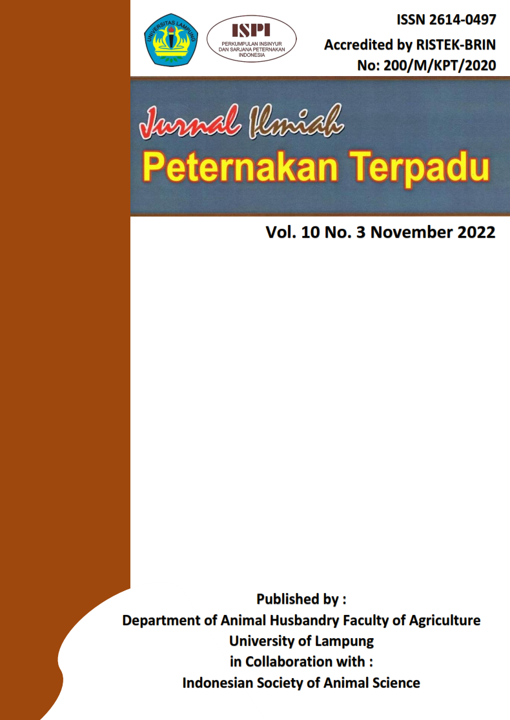Identification of Single Nucleotide Polymorphism (SNP) in Early Exon 10 of Follicle Stimulating Hormone Receptor (FSHR) Gene in Pesisir Cattle
DOI:
https://doi.org/10.23960/jipt.v10i3.p264-276 Abstract View: 1884
Abstract View: 1884
Keywords:
FSHR gene, PCR, Pesisir cattle, SNPAbstract
The purpose of this study was to identify genetic diversity in the early exon 10 of the FSHR gene or follicle stimulating hormone receptor in Pesisir cattle. The blood samples used were 70 blood samples from female Pesisir cattle aged 2-5 years which were obtained from BPTU-HPT Padang Mengatas, West Sumatera. The isolated DNA was then amplified using a pair of primers L and R with PCR technique which produced a fragment with a length of 847 bp. The services of 1st Base Singapore are used for sequencing the amplified product. The results of the research on the identification of the early exon 10 FSHR gene in Pesisir cattle were found that there were 5 SNPs at positions --53T>C, +17A>G, +650C>T, +706A>C and +707 ins>A in some introns 9 to exon 10 first part. The results showed that the genotypic frequency of the Pesisir cattle population was in Hardy-Weinberg imbalance and polymorphisms were found in the early exon 10 FSHR gene diversity.Downloads
References
Afriani, T., M. P. Agusta, Yurnalis, F. Arlina, dan D. E. Putra. 2019. Estimasi dinamika populasi dan pembibitan sapi ppotong di Kecamatan Bayang Kabupaten Pesisir Selatan. Jurnal Peternakan Indonesia, 21(2) : 130-142.
Akbar, N., N.P. Zaman dan H.H. Madduppa. 2014. Keragaman Genetik Ikan Tuna Sirip Kuning (Thunnus Albacares) dari Dua Populasi di Laut Maluku, Indonesia. Depok 3(1): 65-73.
Asaf, V. N. 2014. an Overview On Single Nucleotide Polymorphsm Studies in Mastitis Research. Veterinary world. EISSN: 2231-0916.
Frankham, R., J. D. Ballou, and D.A. Briscoe. 2002. Introduction to Conversation Genetics, Cambridge University Press.
Handoyo, D. and A. Rudiretna. 2001. Prinsip Umum dan Pelaksanaan Polymerase Chain Reaction (PCR). Pusat Studi Bioteknologi, Universitas Surabaya. Unitas, Vol. 9, No. 17-29.
Hartl, D.L and A.G. Clark. 1997. Principle of Population Genetic. Sinauer Associates, Sunderland, MA.
Izawa, T., T. Kawahara, and H. Takahashi. 2007. Genetic Diversity of an Endengered Plant, Cypripedium Macranthos Var. Rebunense (Orchidaceae). Background Genetic Research for Future Convervation. Convervation Genetic. 8:1369-1376.
Leary, R. F., F. W. Allendorf and K. L. Knudsen. 1985. Development Instability and High Meristic Counts in Interspecific Hybrid of Salmonid Fishes. Evolution 39(6): 1318-1326.
Li, X., K. Li, B. Fan, Y. Gong, S. Zhao, Z. Peng and B. Liu. 2000. The Genetic Diversity of Seven Pigs Breeds in China, Estimated by Means of seven pigs breeds in China, estimated by means of micrusatellites, Asian- Australasian Journal of Animal Sciences, 13(9): 1193-1195.
Muladno. 2010. Teknologi Rekayasa Genetika. Edisi ke-2. Bogor, Penerbit IPB Press.
Nasution, R. B. 2013. Identifikasi Keragaman Gen Follicle Stimulating Hormone Receptor (FSHRAlu-1) pada Sapi Lokal Indonesia dengan Teknik PCR-RFLP. Skripsi. Departemen Ilmu Produksi dan Teknologi Peternakan. Fakultas Peternakan. Institut Pertanian Bogor.
Nei, M and S. Kumar. 2000. Molecular Evolution and Phylogenetics. Oxford University Press.
Partodihardjo, S. 1987. Ilmu Reproduksi Hewan. Fakultas Kedokteran Veteriner. Jurusan Reproduksi. IPB.
Purwanto, H. 2012. Identifiksai DNA dan Gen Resisten terhadap Virus AI (Avian Influenza) pada Itik Pitalah sebagai Sumber Daya Genetik Sumatera Barat dengan PCR (Polymerase Chain Reaction). artikel. program pascasarjana. Universitas Andalas.
Rahayu, S., S. B. Sumitro, T. Susilawati dan Soermano. 2006. Identifikasi Polimerfisme Gen GH (Growth Hormone) Sapi Bali dengan Metode PCR-RFLP. Berk. Penel. Hayati: 12(7-11).
Rybicky, E.P. 1996. PCR Primer Design and Reaction Optimisation. In Molecular Biology Techniques Manual. Ed. V.E. Coyne, M.D. James, S.J. Reid & E.P.Rybicki. Dept.of Microbiology. Univ. Cape Town.
Sari, S. A. 2012. Identifikasi Keragaman Gen Follicle Stimulating Hormone Receptor (FSHR|Alu1) Pada Spesies Sapi Bos Javanicus, Bos Taurus, Dan Bos Indicus Dengan Metode PCR-RFLP. Departemen Ilmu Produksi Dan Teknologi Paternakan Fakultas Peternakan. IPB. Bogor.
Simoni M., E. Nieschlag and J. Gromoll. 1997. The Follicle Stimulating Hormone Receptor: biochemistry, molecular biology, physiology, and pathophysiology. Endo. Rev. 18: 413-421.
Sumadi, H., Mulyadi, T. Hartatik, dan R. D. Mundingsari. 2011. Estimasi potensi pembibitan sapi potong di Kecamatan Wonosari Kabupaten Gunung Kidul Daerah Istimewa Yogyakarta. Laporan Hibah Penelitian Tematik Laboratorium. Fakultas Peternakan, Universitas Gajah Mada, Yogyakarta.
Toelihere, M. R. 1979. Fisiologi Reproduksi pada Ternak. Angkasa, Bandung.
Vasconcellos L. P. D., T. Tambasco, A. P. Pereira, L. L. Coutinho, L. C. D. A. Regitano. 2003. Genetic Characterization of Aberden Angus Cattle using Molecular Markers. Genet. Mol. Biol. 26: 133-137.
Warmadewi, D.A. 2017. Mutasi Genetik. Buku Ajar. Fakultas Peternakan. Universitas Udayana. Denpasar.
Yuniarsih, P., Jakaria dan Muladno. 2011. Eksplorasi Gen Growth Hormone Exon 3 Pada Kambing Peranakan Etawah (PE), Saanen dan Pesa melalui Teknik PCR SSCP. Institut Pertanian Bogor, Bogor.
Yurnalis dan Sarbaini. 2014. Keragaman Sekuen Gen Reseptor Hormone Pertumbuhan Exon 10 sebagai Informasi Dasar Seleksi pada Sapi Pesisir Plasma Nuftah Sumatera Barat. Jurnal Peternakan Indonesia, 16 (1), 63-70.
Downloads
Published
How to Cite
Issue
Section
License

Jurnal Ilmiah Peternakan Terpadu(JIPT) is licensed under a Creative Commons Attribution 4.0 International License.
Authors who publish with this journal agree to the following terms:
- Authors retain copyright and grant the journal right of first publication with the work simultaneously licensed under a Creative Commons Attribution License that allows others to share the work with an acknowledgement of the work's authorship and initial publication in this journal.
- Authors are able to enter into separate, additional contractual arrangements for the non-exclusive distribution of the journal's published version of the work (e.g., post it to an institutional repository or publish it in a book), with an acknowledgement of its initial publication in this journal.
- Authors are permitted and encouraged to post their work online (e.g., in institutional repositories or on their website) prior to and during the submission process, as it can lead to productive exchanges, as well as earlier and greater citation of published work (See The Effect of Open Access).





















